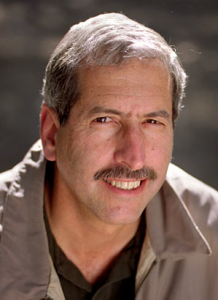26 April 2013
Geophysicist challenges fracking’s bad rep
By Laura Poppick
Mark Zoback, a geophysicist at Stanford University, cringes at the word “fracking”. He doesn’t oppose this controversial process of extracting fossil fuels from shale rock, or hydraulic fracturing. He just laments the stigma of its nickname.
“I am a very strong believer that shale gas can be produced in an environmentally responsible way, and it’s extremely important that we do so,” Zoback said during a lecture held by the Northern California Science Writer’s Association in San Francisco on April 17th. “It’s an essential component of our energy mix for the first half of this century before we can hopefully get away from fossil

Mark Zoback, a professor at Stanford University, researches geological aspects of oil and gas development. Photo credit: Stanford University
fuels altogether.”
Zoback’s optimism did not seem to immediately resonate with his Bay Area audience. Californians, like many citizens across the country, are increasingly wary of the push to extract untapped gas and oil in this way, particularly within their already water-stressed land. They fear the pollution that has been associated with fracking, and its potential threat to their health and to the state’s agricultural economy.
But Zoback dismisses these apprehensions as ill-informed. He has studied geophysics with an emphasis on shale gas and oil production for more than 30 years and, in 2011, sat on a committee appointed by then-U.S. Secretary of Energy Steven Chu to inform President Obama of the environmental risks associated with fracking. The committee concluded that, with thoughtful engineering and robust regulations, hydraulic fracturing can, indeed, be done safely.
“The three keys to developing shale gas in an environmentally responsible manner are well construction, well construction, and well construction,” Zoback said.
Some Californians worry that toxic fracking fluid could leak out of deep cracks and contaminate drinking water, regardless of how the wells are constructed higher up. But Zoback argued that, while this may be a risk elsewhere in the world, it is not a serious threat in the U.S. Our frackable shale lies about one mile underground. This thick layer of rock provides a safe buffer between deep toxic fluids and near-surface aquifer water, he said.
Still, problems can — and do — occur closer to the surface. If companies don’t line their well-heads properly, gas can leak and travel upward into groundwater. The American Petroleum Institute acknowledges this, and recommends that companies line the upper portion of their wells with steel casing and a 500-foot-long layer of cement. Zoback thinks additional steel layers, and up to 2,000 feet of cement, would be even better.
“[Fracking] is a complicated process, and it needs to be done properly and needs to be regulated properly,” Zoback said during his talk.
In California, the Senate is currently considering a bill that would create new state fracking regulations, including restrictions on water use and disposal. And, earlier this month, the Sierra Club and the Center for Biological Diversity — an Arizona-based environmental law nonprofit with an office in San Francisco — won a lawsuit against the federal Bureau of Land Management for failing to adequately assess the environmental impacts of leasing land to oil and gas companies planning to hydraulically fracture California plots in 2011.
Finding neither those movements nor Zoback’s optimism reassuring, some skeptics in the audience last week challenged the speaker’s reasoning. The speed and magnitude of the expected surge in California fracking could pose unforeseen environmental issues, one audience member pointed out. Others doubted that new regulations would be as robust as they need to be.
Zoback remained resolutely upbeat.
“I think like an engineer,” he said. “I look at a system, identify the problems, and then I try to find solutions to the problems. If there are problems associated with hydraulic fracturing, I will seek solutions.”
Laura Poppick is a graduate student in the University of California Santa Cruz Graduate Program in Science Communication, where she reported on Zoback’s talk for the student blog Out of the Fog . Poppick, who has a B.S. in geology from Bates College in Lewiston, ME., also covers science and technology as an intern at Wired Science.
Mark Zoback is an AGU member, and was named an AGU Fellow in 1998.


 GeoSpace is a blog on Earth and space science, managed by AGU’s Public Information staff. The blog features posts by AGU writers and guest contributors on all sorts of relevant science topics, but with a focus on new research and geo and space sciences-related stories that are currently in the news.
GeoSpace is a blog on Earth and space science, managed by AGU’s Public Information staff. The blog features posts by AGU writers and guest contributors on all sorts of relevant science topics, but with a focus on new research and geo and space sciences-related stories that are currently in the news.